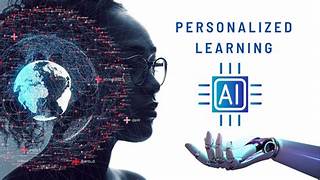Investigating the Impact of Machine Learning in Personalized Education Systems
Introduction
Education is evolving rapidly with technological advancements, and one of the most significant developments in recent years has been the integration of artificial intelligence (AI) and machine learning (ML) into personalized education systems. Traditional classroom settings often struggle to cater to the diverse learning needs of students, leading to gaps in comprehension and engagement. Machine learning offers a solution by enabling personalized education tailored to individual learning styles, progress rates, and knowledge gaps.
This article explores how machine learning is transforming education, its benefits, challenges, and future prospects in creating a more effective and inclusive learning environment.
Understanding Machine Learning in Education
Machine learning is a subset of AI that enables systems to learn from data, identify patterns, and make informed predictions without explicit programming. In education, ML algorithms analyze student behavior, performance, and preferences to offer customized learning experiences. This technology is used in:
- Adaptive Learning Platforms: Systems that adjust learning materials based on student performance and understanding.
- Intelligent Tutoring Systems: AI-powered tutors that provide real-time feedback and assistance.
- Automated Grading and Assessment: AI tools that evaluate assignments, tests, and projects efficiently.
- Predictive Analytics: Algorithms that forecast student outcomes and potential learning difficulties.
How Machine Learning Personalizes Education
The application of machine learning in education involves multiple steps, each contributing to an enhanced learning experience tailored to individual students.
1. Data Collection and Analysis
Machine learning relies on extensive data collection from various sources, including:
- Student quizzes, assignments, and test scores.
- Interaction patterns within online learning platforms.
- Time spent on different topics or problem-solving activities.
- Feedback and engagement levels with educational materials.
This data is then analyzed to determine each student’s strengths, weaknesses, and preferred learning methods.
2. Adaptive Learning Pathways
Based on data analysis, ML-driven systems adjust learning paths to match the student’s pace and comprehension level. For example:
- If a student struggles with algebra but excels in geometry, the system will allocate more time and resources to improving algebra skills.
- Visual learners may receive more video-based explanations, while others may get text-based content.
- ML algorithms can predict when a student is likely to disengage and introduce interactive activities to maintain interest.
3. Intelligent Tutoring Systems (ITS)
ITS platforms act as virtual tutors, offering real-time guidance and explanations. These systems use:
- Natural Language Processing (NLP) to interact with students in conversational formats.
- Speech and Text Recognition to analyze spoken or written queries.
- Problem-Solving Models to guide students through exercises step by step.
Examples include chatbots that assist with math problems or virtual assistants that provide writing feedback.
4. Automated Assessments and Feedback
Machine learning enables automated grading and assessment systems that provide instant feedback. These systems analyze answers, identify mistakes, and offer suggestions for improvement. Benefits include:
- Reduced grading time for teachers.
- Immediate feedback that helps students correct mistakes in real time.
- Objective evaluation free from human bias.
5. Predictive Analytics for Student Success
ML algorithms analyze historical data to predict students’ future performance. Educational institutions use these insights to:
- Identify at-risk students who may need extra support.
- Recommend personalized study plans to improve performance.
- Optimize course content based on learning trends and student feedback.
Benefits of Machine Learning in Personalized Education
1. Improved Learning Outcomes
Personalized education ensures that each student learns at their own pace, reducing frustration and increasing retention. Students receive targeted resources that enhance their understanding of complex subjects.
2. Enhanced Student Engagement
Machine learning identifies disengaged students and adapts lessons to maintain their interest. Gamification elements, interactive simulations, and AI-driven quizzes make learning more enjoyable.
3. Greater Accessibility and Inclusivity
ML-powered education platforms accommodate students with disabilities by offering:
- Speech-to-text and text-to-speech features for visually or hearing-impaired students.
- Adaptive testing methods that adjust difficulty levels based on performance.
- AI tutors that provide one-on-one assistance for students needing extra support.
4. Efficiency for Educators
Teachers spend less time on repetitive tasks such as grading and content delivery, allowing them to focus on individualized instruction and student mentorship.
5. Scalable Learning Solutions
Machine learning enables scalable education solutions that benefit students in remote or underprivileged areas. Online platforms powered by ML provide quality education to a broader audience, bridging educational gaps globally.
Challenges and Limitations of Machine Learning in Education
1. Data Privacy and Security Concerns
ML systems require extensive data on student behavior and performance, raising concerns about privacy and data security. Educational institutions must implement strict policies to protect sensitive information.
2. Dependence on Technology
Over-reliance on ML-powered education may reduce critical thinking and problem-solving skills if students become too dependent on AI tutors.
3. Bias in AI Algorithms
If not carefully designed, ML models can reinforce biases in educational materials. AI systems must be trained on diverse datasets to ensure fairness in learning recommendations.
4. High Implementation Costs
Developing and maintaining AI-driven education platforms requires significant investment, which may be a barrier for some institutions.
5. Need for Human Oversight
While ML enhances learning, human teachers remain essential for fostering creativity, emotional intelligence, and critical thinking skills. AI should complement, not replace, educators.
Future Prospects of Machine Learning in Education
As machine learning technology continues to evolve, several advancements will further enhance personalized education systems:
- Improved AI Tutors: More sophisticated AI tutors capable of deep conversations and complex problem-solving.
- Augmented Reality (AR) and Virtual Reality (VR) Integration: AI-driven immersive learning experiences.
- Real-Time Emotional AI: Systems that detect student emotions and adapt content accordingly.
- Lifelong Learning Platforms: AI-driven education for continuous skill development beyond traditional schooling.
Conclusion
Machine learning is revolutionizing education by providing personalized, engaging, and efficient learning experiences. From adaptive learning systems and intelligent tutoring to predictive analytics, ML empowers students and educators alike. While challenges remain, the future of AI in education looks promising, offering solutions that make learning more accessible, effective, and tailored to individual needs. As technology advances, integrating machine learning into education will be key to shaping the next generation of learners and preparing them for an increasingly digital world.


